When the ginkgo trees turn golden, when the flower seller has seas of long-tendriled chrysanthemums and the vegetable seller has pumpkins of all shapes and sizes, then we know that fall has arrived. Beijing’s autumn is its most beautiful season, but also its most fleeting. Thinking of autumnal treats back home, Thanksgiving feasts and pumpkin sweets, I made these pumpkin mochi filled with black-sesame and red bean paste. With their gold and black coloring, they are even, quite accidentally, in the spirit of Halloween.
The combination of ground black sesame (heizhima 黑芝麻) and red bean paste is not traditional, but it is one of my favorites. On its own, red bean paste (dousha 豆 沙) is quite sweet and a bit one-dimensional, and the addition of roasted, ground black sesame gives it nuttiness, richness, and depth. This makes it a perfect friend to the subtly sweet pumpkin, in flavor as well as looks – what more autumnal colors than deep burgundy and gold?
Mochi is very easy to make, and fun, too. Though the pumpkin shape may look difficult, glutinous rice flour comes together as a very forgiving dough, pliable and easily molded. The key is to not add to much water during the dough mixing.
Pumpkin mochi balls with black sesame and red bean paste
In China, the vast majority of glutinous rice flour (jiangmi fen 江米粉 or nuomi mian 糯 米粉) is not sold pure – it already has plain rice flour mixed in to give it the right consistency for mochi and other sticky rice treats. However, in the US, most glutinous rice flour (aka mochiko or sweet rice flour) is pure and should be mixed with other flours in order not to become a sticky mess. For this recipe, you’ll want to replace 25 grams (just under 3 tablespoons) of the glutinous rice flour with the same quantity of regular rice flour (mifen 米粉), pastry flour or other low-gluten flours.
The dough
pumpkin puree¹ 200g (3/4 cup)
glutinous rice flour 175g (7/8 cup)
tapioca flour (mushu fen 木薯粉) 24g (3 tablespoons)
canola or other flavorless oil 1 tsp
water, as neededThe filling
sweet red bean paste 150g
ground black sesame² 35g (7 tablespoons)
roasted sesame paste³ 2 teaspoonsraisins, goji berries, or chopped nuts (for stem, optional)
1. The dough: Mix the pumpkin puree with the glutinous rice (mochiko) flour and tapioca flour, and if using, the rice/low-gluten flour. Add the canola oil, and mix thoroughly, kneading to make sure that all flour has been incorporated.
2. Test the consistency: Tear off a small piece of dough, shape it into a ball, and then gently stretch it into a relatively thin disc. If the dough tears apart easily and feels stiff, add a splash of water, and mix thoroughly. Repeat the test again – the final dough should be neither crumbly nor too smooth and supple. It will still tear slightly when flattened into a disc, but it will also mend easily and hold its shape. Don’t add more than a teaspoon or two of water.
3. The filling: Cover the dough and set aside. Mix together red bean paste, ground black sesame, and roasted sesame paste. You can use the filling as is, or pre-shape it for greater convenience: scoop out approximately spoonfuls of filling around 1.5 tsp in size, and roll each spoonful into a small, slightly flattened ball. The balls can be frozen for a few minutes to help them retain their shape.
4. Prepare the steamer: Cover the bottom of your steamer with parchment paper, leaves of lettuce or cabbage, or corn husks that I saved and dried for this purpose. This will keep your mochi from sticking to the steamer. You can also slice thin coins of carrot and sit each mochi on its own little carrot platform. Oiling the steamer does not work as the mochi will only absorb the oil.
5. Making the mochi: Tear off a small knob of pumpkin mochi dough, about the size of a walnut, and gently flatten it into a disc, ideally less than ¼-inch thin. The disc should only be slightly bigger than the filling, or else you will have excess dough. Place a scoop of filling into the middle, then bring up the edges of the dough around it, completely encasing the filling. Sealing the edges together and gently smooth out all the seams until you have a round, perfect mochi ball. Set on your prepared non-stick surface (see step #4).
Don’t be too ambitious in the size of your filling until you are more confident in your wrapping skills. Repeat until you are out of dough, filling, or both. I made small mochi, and I had a spoonful or two of leftover filling, as I had intended – it’s very delicious straight out of the bowl. Ahem. Leftover dough can still be shaped into un-stuffed mochi balls and steamed.
5. Making the pumpkin marks: Using the dull upper-side of a butter knife, gently press indentations all around the pumpkin. Don’t use the sharp side, or you may cut open the mochi. You can also create a small depression in the center and decorate the pumpkin with a “stem”.
6. Steaming the mochi: Boil water. Place the steamer on the pot after the water comes to a roiling boil. Steam for 10 minutes, then turn off the heat, but leave the mochi in the steamer with the lid on for a minute longer. Then remove the steamer, take off the lid, and let cool slightly before removing mochi. They are best enjoyed while warm (but not hot), and keep for a few days.
¹ To make pumpkin puree, you can either roast pumpkin halves in the oven at 175°C/350°F, or you can chop the pumpkin into small cubes and steam until tender. The larger your chunks, the longer the steaming time.
² If ground black sesame seeds are not available, you can make your own by first heating raw black sesame seeds in a wok until nutty and fragrant, then processing them through a blender of food processor. In Beijing, I buy ground black sesame seeds at the wet market annex that is inside but separate from the big Wumei supermarket (Wu-mart 物美) on Dongsi Beidajie and Chaoyangmennei; there’s a vendor all the way in, next to the noodle stands, that sells bags of them.
³ Sesame paste (zhima jiang 芝麻酱) are available fresh from the above-mentioned sesame seed seller in the Wumei, and here. They are also sold in jars in grocery stores.
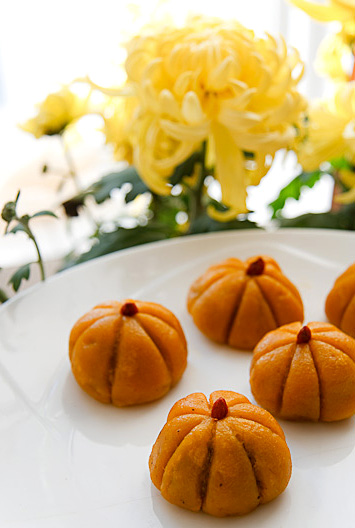
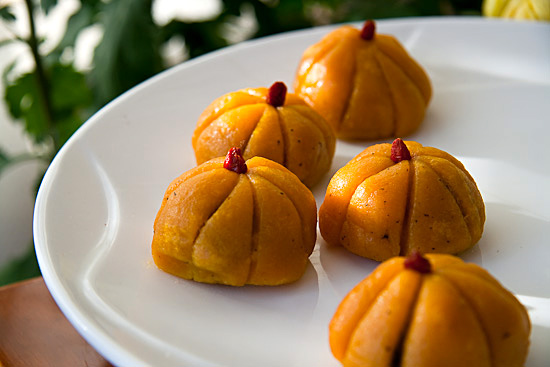
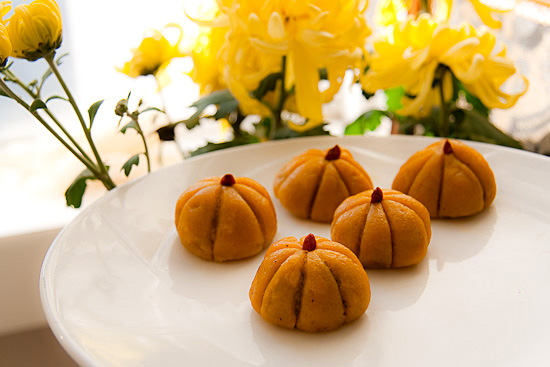
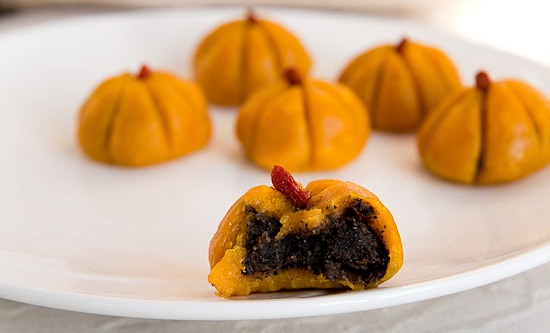
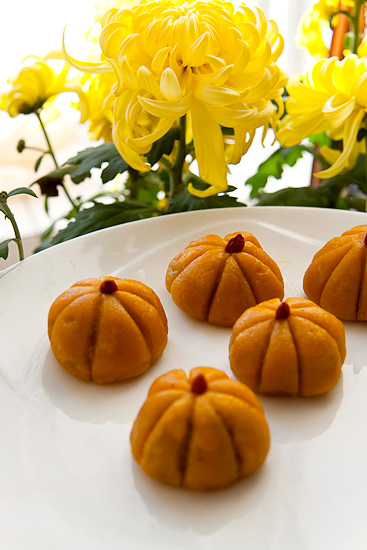


































these are the cutest mochi i have ever seen and they look so tasty too! i will definitely make these soon :)
these are the cutest things EVER. i like the goji on top.
i want to learn how to make mochi! it seems to daunting though. and sticky. good thing a long winter is coming up… need more cooking projects!
Awesome blog! I can’t believe we’ve been in Beijing for three months without finding this. Thanks for the recommendations.
[...] from Haw Berries and Kumquats Share this:TwitterMoreFacebookGooglePinterestPrintEmailLike this:Like [...]
[...] from Haw Berries and Kumquats Share this:TwitterMoreFacebookGooglePinterestPrintEmailLike this:Like [...]